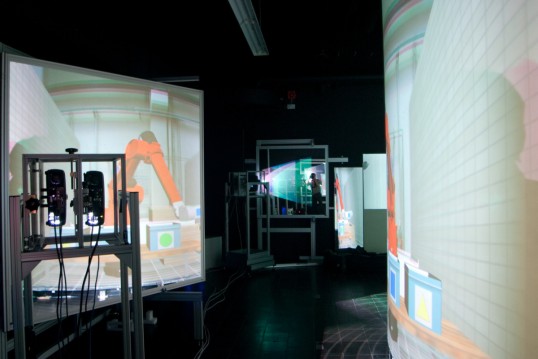- Artificial Intelligence (AI)
- Occupational exposure limit values
- Climate Change and Occupational Safety
- List of CMR substances
- Ergonomics
- EU GHS Regulation
- Industrial Security
- Collaborative robots
- Noise
- Nanoparticles at the workplace
- REACH
- Reference materials
- Proficiency testing
- Radiation
- Vibration
- Virtual reality
- Work 4.0
Safety and Usability through Applications in Virtual Environments (SUTAVE)

A look "behind the scenes"; shows dual projectors and mirrors for rear projection onto the 3 x 8 m curved screen in the SUTAVE laboratory
Source: IFA
Safety and Usability through Applications in Virtual Environments (SUTAVE) describes the use of virtual reality (VR) for problem solving and for innovative design in the area of occupational safety and health.
The IFA has a dedicated SUTAVE laboratory. Work processes can be studied in a simulated work system in this laboratory. Within this three-dimensional, dynamic model of reality, participants carry out the specified tasks in a virtual working environment, at a simulated workplace, and with simulated work equipment. With this arrangement, SUTAVE permits realistic applications and facilitates interdisciplinary discussion and co-operation between the spheres of industry, research, and occupational safety and health. This virtual reality is:
- Realistic: the person's interaction with the virtual work system has direct effects upon their processing of information.
- Interactive: the person acts with the virtual work system, processes information directly, and implements it without delay.
- Illustrative and readily comprehensible: this facilitates discussion between different disciplines
- Animated: parts of the work system move of their own accord, or can be moved.
- Perceived dynamically: the visual, acoustic and tactile perception change, leading in turn to changes in the projection of the virtual work system. This occurs according to where the person is standing, how they move, and how the simulated environment moves relative to them.
- Safe: hazards can be simulated realistically without actually endangering human beings
Equipment of the IFA's SUTAVE laboratory
